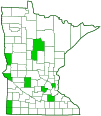Sunflower tortoise beetle
(Physonota helianthi)
Conservation • Description • Habitat • Ecology • Distribution • Taxonomy
Conservation Status |
|||
| IUCN Red List | not listed |
||
| NatureServe | not listed |
||
| Minnesota | not listed |
||
Description |
Sunflower tortoise beetle is a small leaf beetle. It occurs in the United States east of the Great Plains and in adjacent Canadian provinces. An unconnected (disjunct) population occurs in Mexico and Central America. It is uncommon throughout its range. Adults are tortoise-shaped, 5 ⁄16″ to ½″ (7.5 to 12 mm) long, oval when viewed from above, and convex when viewed from the side. The female is larger than the male. There are three color phases that each adult undergoes. The teneral adult, freshly emerged (eclosed) from the pupal stage, is soft bodied and dingy white or ivory. The intermediate adult is black and white. This phase lasts about three weeks. The mature adult is entirely iridescent green. The upper thoracic plate (pronotum) and the two hardened wing covers (elytra) each have a semi-transparent covering over the entire surface. The head is completely concealed beneath the pronotum when viewed from above. The eyes are not notched. The antennae are long but less than half as long as the body. Segment 3 is distinctly longer than segment 2, and segment 8 is distinctly longer than wide. The antennae are extended when at rest. There is no groove on the underside of the prothorax for them to be tucked into. The front (anterior) edge of the pronotum is broadly rounded. The corners at the base are at right angles. On the intermediate adult the pronotum is white with 5 black spots. There is one small spot on each side near the rear margin, one small spot in the upper middle, and two larger spots near the front margin that sometimes merge into a single wide spot. On the mature adult the pronotum is iridescent green with the three small spots but no large spots. The upper surfaces of the elytra are covered with small punctures but are not deeply pitted or wrinkled. The outer margins of the transparent covering are broadly spread out, flattened, thin, and extend over the legs. On the intermediate adult, the elytra are black with numerous white spots. The inner margin of each elytron, together called the suture, is yellowish-brown. The plate between the wing bases (scutellum) is small and triangular. It is black but mostly covered with a white spot. On the mature adult the elytra and scutellum are entirely iridescent green and the suture slightly darkened. The last part of leg (tarsus), corresponding to the foot, has five segments. The fourth segment is very short and is concealed within the broadened tip of the third segment, making the tarsus appear to have only four segments. The last segment bears a pair of well-developed claws. |
Size |
Total length: 5 ⁄16″ to ½″ (7.5 to 12 mm) |
Similar Species |
Habitat |
|
Ecology |
Season |
One generation per year |
Behavior |
Both larvae and adults feed on the underside of leaves. They occasionally defoliate the plant and can be a major pest. Larvae carry dried fecal matter over their body, presumably as a form of camouflage. The fecal matter is attached to a forked appendage on the last abdominal segment, and is held suspended over the body. |
Life Cycle |
Adults overwinter |
Larva Food |
Same as the adult |
Adult Food |
Leaves of sunflowers (Helianthus spp.) |
Distribution |
||
|
Sources |
|
| 9/1/2025 | ||
Occurrence |
||
|
||
Taxonomy |
|
Order |
Coleoptera (Beetles) |
Suborder |
Polyphaga (Water, Rove, Scarab, Long-horned, Leaf, and Snout Beetles) |
Infraorder |
Cucujiformia |
Superfamily |
Chrysomeloidea (leaf beetles and allies) |
Family |
Chrysomelidae (leaf beetles) |
Subfamily |
Cassidinae (tortoise and hispine beetles) |
Tribe |
Ischyrosonychini |
Genus |
Physonota |
Subordinate Taxa |
|
|
|
Synonyms |
|
Physonota quinquepunctata |
|
Common Names |
|
sunflower tortoise beetle |
|
Glossary
Elytra
The hardened or leathery forewings of beetles used to protect the fragile hindwings, which are used for flying. Singular: elytron.
Pronotum
The exoskeletal plate on the upper side of the first segment of the thorax of an insect.
Scutellum
The exoskeletal plate covering the rearward (posterior) part of the middle segment of the thorax in some insects. In Coleoptera, Hemiptera, and Homoptera, the dorsal, often triangular plate behind the pronotum and between the bases of the front wings. In Diptera, the exoskeletal plate between the abdomen and the thorax.
Tarsus
On insects, the last two to five subdivisions of the leg, attached to the tibia; the foot. On spiders, the last segment of the leg. Plural: tarsi.
Visitor Photos |
Share your photo of this insect. |
||
This button not working for you? |
||
Frances Meinhart |
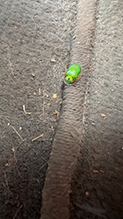 |
I was cleaning out my vehicle and saw this little guy…it’s the 1st time I’ve ever seen one…where would it have come from? |
MinnesotaSeasons.com Photos |
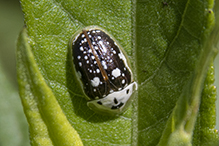 |
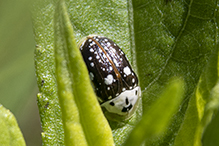 |
|
Intermediate adult |
Intermediate adult |
|
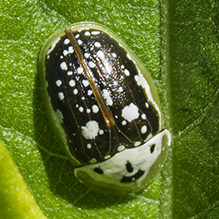 |
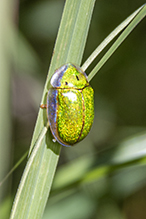 |
|
Intermediate adult |
Mature adult |

Slideshows |
|

Visitor Videos |
Share your video of this insect. |
||
This button not working for you? |
||
|
Other Videos |
|

Visitor Sightings |
Report a sighting of this insect. |
||
This button not working for you? |
||
MinnesotaSeasons.com Sightings |

